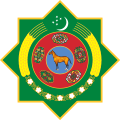| This article needs additional citations for verification. Please help improve this article by adding citations to reliable sources. Unsourced material may be challenged and removed. Find sources: "Rub el Hizb" – news · newspapers · books · scholar · JSTOR (March 2024) (Learn how and when to remove this message) |
| ۞ | |
|---|---|
| Rub el Hizb | |
| In Unicode | U+06DE ۞ ARABIC START OF RUB EL HIZB |

The Rub el Hizb (Arabic: رُبْعُ الْحِزْبِ or رُبُعُ الْحِزْبِ, romanized: rubʿ al-ḥizb, lit. 'quarter of the party') is an Islamic symbol in the shape of an octagram, represented as two overlapping squares ۞. While its main utility today is to mark a division inside some copies of the Quran to facilitate recitation, it has originally featured on a number of emblems and flags in the past and continues to do so today.
In Arabic, rubʿ means 'one-fourth' or 'quarter', while ḥizb (plural aḥzāb) translates to 'a group'. The Quran is divided into 60 aḥzāb (groups of roughly equal length in turn grouped into 30 ajzāʾ), with instances of Rub el Hizb further dividing each ḥizb into four, for a total of 240 divisions.
The Seljuk star is an eight-pointed star polygon that is an ancient Turkish national symbol (Tamga). It is a common motif in Seljuk art. The symbol is also incorporated into the presidential flag of Turkmenistan.
History
The symbol was used as a cultural symbol in the time of Al-Andalus in the Iberian Peninsula, appearing on the coins. In addition, the use of it in so many areas led to its name being changed to "the star of Abd al-Rahman I". From al Al-Andalus it was exported to the rest of the Arab world. It has also been used extensively in Turkic Islamic culture and history.
Variants
Contemporary use
Architecture

The symbol has been used as a basis for plans of buildings, as in the case of the Petronas Towers.
Former flags
-
 An Ottoman flag with an eight pointed star (after 1844)
An Ottoman flag with an eight pointed star (after 1844)
-
 Flag of the Emirate of Afghanistan (1919–1926)
Flag of the Emirate of Afghanistan (1919–1926)
Current flags
-
 Flag of Azerbaijan
Flag of Azerbaijan
-
 Flag of the Kazakhstan Customs Bureau
Flag of the Kazakhstan Customs Bureau
-
 Flag of the Organization of Turkic States
Flag of the Organization of Turkic States
-
 Standard of the President of Turkmenistan
Standard of the President of Turkmenistan
-
 Standard of the President of Uzbekistan
Standard of the President of Uzbekistan
Emblems
See also
- Anatolian Seljuk architecture
- Armenian eternity sign
- Borjgali
- Lists of national symbols
- Sujud
- Star of Lakshmi
- Star of Ishtar
- Shamsa
- Mandala
- Surya Majapahit
- Octagram
References
- Dumas, Hillary; Dumas, D. G. (1989). Trefoil: Guls, Stars & Gardens : an Exhibition of Early Oriental Carpets, Mills College Art Gallery, January 28-March 11, 1990. Hillary Dumas. pp. vii. ISBN 978-0-9629236-0-9.
- Rizvi, Kishwar (2015). The Transnational Mosque: Architecture and Historical Memory in the Contemporary Middle East. UNC Press Books. ISBN 978-1-4696-2117-3.
- "Eight-Pointed Star Meaning". Antique Rugs by Doris Leslie Blau. 2019-02-01. Retrieved 2023-09-11.
- Reki, Mahina; Arslan Selçuk, Semra (2018-05-22). "Evolution of Geometric Patterns in Islamic World and a Case on the Jalis of the Naulakha Pavilion in the Lahore Fort". Gazi University Journal of Science. Part B: Art, Humanities, Design and Planning. 6 (1): 83–97.
- Galal Abada (2004). "Petronas Office Towers" (PDF). Kuala Lumpur, Malaysia. Archived from the original on 2012-10-01.





